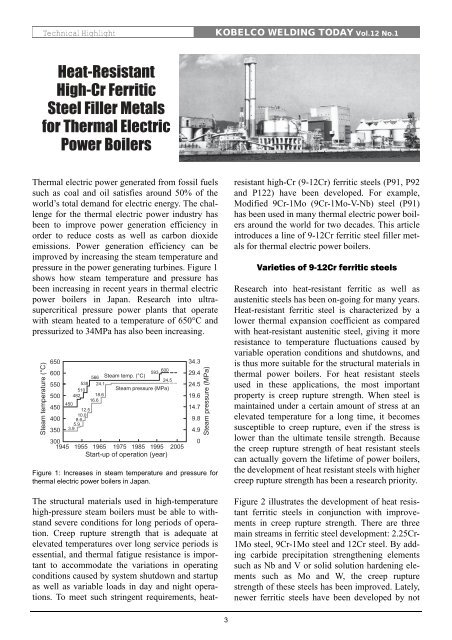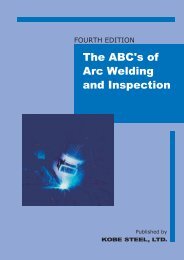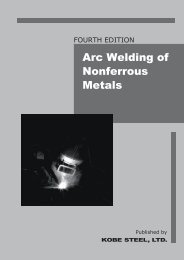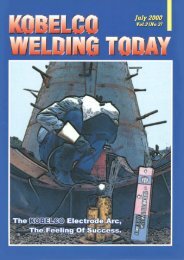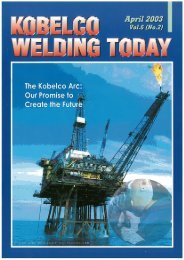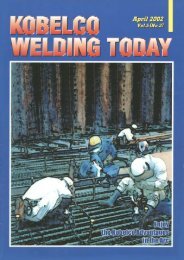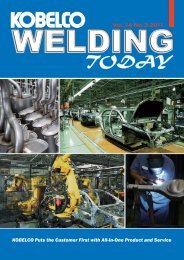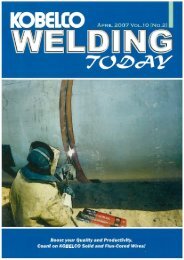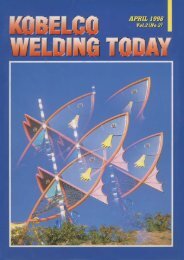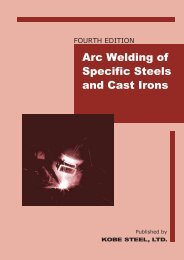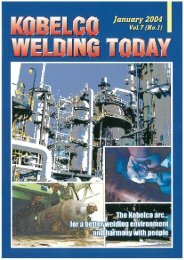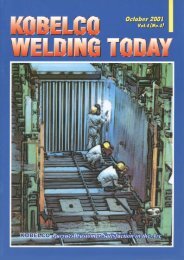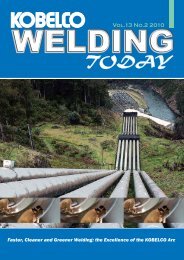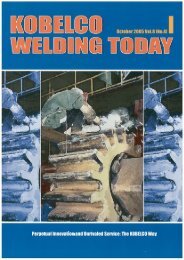Kobelco Welding Today Vol.12 No.1 2009
Kobelco Welding Today Vol.12 No.1 2009
Kobelco Welding Today Vol.12 No.1 2009
Create successful ePaper yourself
Turn your PDF publications into a flip-book with our unique Google optimized e-Paper software.
Technical Highlight<br />
KOBELCO WELDING TODAY <strong>Vol.12</strong> <strong>No.1</strong><br />
<br />
<br />
<br />
<br />
<br />
Thermal electric power generated from fossil fuels<br />
such as coal and oil satisfies around 50% of the<br />
world’s total demand for electric energy. The challenge<br />
for the thermal electric power industry has<br />
been to improve power generation efficiency in<br />
order to reduce costs as well as carbon dioxide<br />
emissions. Power generation efficiency can be<br />
improved by increasing the steam temperature and<br />
pressure in the power generating turbines. Figure 1<br />
shows how steam temperature and pressure has<br />
been increasing in recent years in thermal electric<br />
power boilers in Japan. Research into ultrasupercritical<br />
pressure power plants that operate<br />
with steam heated to a temperature of 650°C and<br />
pressurized to 34MPa has also been increasing.<br />
<br />
<br />
<br />
<br />
<br />
<br />
<br />
<br />
<br />
<br />
<br />
<br />
<br />
<br />
<br />
<br />
<br />
<br />
<br />
<br />
<br />
<br />
<br />
<br />
<br />
<br />
<br />
<br />
<br />
<br />
<br />
<br />
<br />
Figure 1: Increases in steam temperature and pressure for<br />
thermal electric power boilers in Japan.<br />
The structural materials used in high-temperature<br />
high-pressure steam boilers must be able to withstand<br />
severe conditions for long periods of operation.<br />
Creep rupture strength that is adequate at<br />
elevated temperatures over long service periods is<br />
essential, and thermal fatigue resistance is important<br />
to accommodate the variations in operating<br />
conditions caused by system shutdown and startup<br />
as well as variable loads in day and night operations.<br />
To meet such stringent requirements, heatresistant<br />
high-Cr (9-12Cr) ferritic steels (P91, P92<br />
and P122) have been developed. For example,<br />
Modified 9Cr-1Mo (9Cr-1Mo-V-Nb) steel (P91)<br />
has been used in many thermal electric power boilers<br />
around the world for two decades. This article<br />
introduces a line of 9-12Cr ferritic steel filler metals<br />
for thermal electric power boilers.<br />
Varieties of 9-12Cr ferritic steels<br />
Research into heat-resistant ferritic as well as<br />
austenitic steels has been on-going for many years.<br />
Heat-resistant ferritic steel is characterized by a<br />
lower thermal expansion coefficient as compared<br />
with heat-resistant austenitic steel, giving it more<br />
resistance to temperature fluctuations caused by<br />
variable operation conditions and shutdowns, and<br />
is thus more suitable for the structural materials in<br />
thermal power boilers. For heat resistant steels<br />
used in these applications, the most important<br />
property is creep rupture strength. When steel is<br />
maintained under a certain amount of stress at an<br />
elevated temperature for a long time, it becomes<br />
susceptible to creep rupture, even if the stress is<br />
lower than the ultimate tensile strength. Because<br />
the creep rupture strength of heat resistant steels<br />
can actually govern the lifetime of power boilers,<br />
the development of heat resistant steels with higher<br />
creep rupture strength has been a research priority.<br />
Figure 2 illustrates the development of heat resistant<br />
ferritic steels in conjunction with improvements<br />
in creep rupture strength. There are three<br />
main streams in ferritic steel development: 2.25Cr-<br />
1Mo steel, 9Cr-1Mo steel and 12Cr steel. By adding<br />
carbide precipitation strengthening elements<br />
such as Nb and V or solid solution hardening elements<br />
such as Mo and W, the creep rupture<br />
strength of these steels has been improved. Lately,<br />
newer ferritic steels have been developed by not<br />
3


